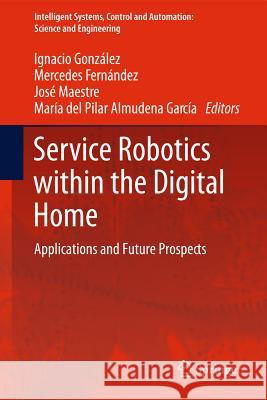Service Robotics within the Digital Home: Applications and Future Prospects » książka



Service Robotics within the Digital Home: Applications and Future Prospects
ISBN-13: 9789400714908 / Angielski / Twarda / 2011 / 174 str.
Service Robotics within the Digital Home: Applications and Future Prospects
ISBN-13: 9789400714908 / Angielski / Twarda / 2011 / 174 str.
(netto: 383,36 VAT: 5%)
Najniższa cena z 30 dni: 385,52
ok. 22 dni roboczych
Dostawa w 2026 r.
Darmowa dostawa!
This book provides a clear and precise description of the Smart houses and Robotics Systems on the market, their interoperability and the future perspective. It shows the different standards and the development platforms used by the main service robots.
Glosariusz/słownik
Wydanie ilustrowane
Table of Contents.- Abbrevations.- Preface.- Introduction.- 1. Interoperability Systems.- 1.1. Introduction.- 1.2. UPnP.- 1.2.1. Introduction.- 1.2.2. General features.- 1.2.3. Specific features.- 1.2.4. Protocols.- 1.2.5 Components of a UPnP network.- 1.2.6. UPnP running.- 1.2.7. Penetration in the market.- 1.3. OSGi.- 1.3.1. Introduction.- 1.3.2. General features.- 1.3.3. Specific features.- 1.3.4. Organization.- 1.3.5. Penetration in the market.- 1.4. Jini.- 1.4.1. Introduction.- 1.4.2. General features.- 1.4.3. Specific features.- 1.4.4. Organization of the Jini architecture.- 1.4.5. Penetration in the market.- 1.5. DLNA.- 1.5.1. Introduction.- 1.5.2. General features.- 1.5.3. Specific features.- 1.5.4. Penetration in the market.- 1.6. Other standards.- 1.6.1. Salutation.- 1.6.2. Service Location Protocol (SLP).- 1.6.3. Ad-hoc developments.- 2 Robotic Development.- 2.1 Introduction.- 2.1.1 General characteristics of development platforms.- 2.1.1.1 Standard Template Library (STL).- 2.1.1.2 Microsoft Foundation Class Library (MFC).- 2.1.1.3 Open Graphics Library (OpenGL).- 2.1.2 Robotic Middleware and Development Platforms.- 2.1.2.1 CARMEN (Carnegie Mellon Navigation Toolkit).- 2.1.2.2 Miro (Middleware for Mobile Robot Applications).- 2.1.2.3 OROCOS (Open RObot COntrol Software).- 2.1.2.4 Player.- 2.1.2.5 Urbi.- 2.1.2.6 Orca.- 2.1.2.7 OpenRDK.- 2.1.2.8 CLARAty.- 2.1.3 Robotic Simulators.- 2.1.3.1 Microsoft Robotics Studio.- 2.1.3.2 Webots.- 2.1.3.3 Stage/Gazebo.- 2.1.3.4 MARIE (Mobile and Autonomous Robotics Integration Environment).- 2.1.3.5 AnyKode Marilou.- 2.1.3.6 USARSim.- 2.1.3.7 EyeSim/EyeBot.- 2.1.3.8 MobileSim.- 2.1.4 Simulators for communication protocols.- 2.1.4.1 OPNET Modeler.- 2.1.4.2 OMNeT++.- 2.1.4.3 NS-2 y NS-3 (Network Simulator).- 2.1.4.4 GloMoSim.- 2.1.4.5 IPC.- 2.1.5 The Numerical Simulation.- 2.1.6 Discussion.- 2.2 Architectural patterns for robotic development.- 2.2.1 Layered view.- 2.2.1.1 Layers.- 2.2.1.2 Indirection layer.- 2.2.2 Data Flow view.- 2.2.2.1 Batch Sequential.- 2.2.2.2 Pipes and Filters.- 2.2.3 Data Centered view.- 2.2.3.1 Active Repository.- 2.2.3.2 Blackboard.- 2.2.4 Adaption view.- 2.2.4.1 Microkernel.- 2.2.4.2 Reflection.- 2.2.4.3 Interceptor.- 2.2.5 Language Extensions view.- 2.2.5.1 Interpreter.- 2.2.5.2 Virtual Machine.- 2.2.5.3 Rule-based System.- 2.2.6 Distribution view.- 2.2.6.1 Broker.- 2.3 Player/Stage.- 2.3.1 General features.- 2.3.2 Specific features.- 2.3.2.1 Player.- 2.3.2.2 Stage.- 2.3.2.3 Gazebo.- 2.3.2.4 Differences between Stage and Gazebo.- 2.4 Microsoft Robotics Developer Studio.- 2.3.1 General features.- 2.3.2 Specific features.- 2.3.2.1 End-to-end development platform.- 2.3.2.2 Runtime services.- 2.3.2.3 Scalable and extensible platform.- 2.3.3 Differences with Player/Stage.- 2.4 Webots.- 2.4.1 General features.- 2.4.1.1 Robot and environment editor.- 2.4.1.2 Realistic simulation.- 2.4.1.3 Programming interface.- 2.4.1.4 Transference to real robots.- 2.4.2 Implementations.- 2.4.2.1 Khepera.- 2.4.2.2 Aibo.- 2.4.2.3 NAO.- 3. Service Robotics.- 3.1 Introduction.- 3.2 Personal service.- 3.2.1 Cleaning and Vacuuming.- 3.2.1.1 Roomba and Scooba:.- Notes about development with Roomba Robots for the Digital Home.- 3.2.1.2 Mint automatic Floor Cleaner.- 3.2.1.3 IClebo Cleaning solutions.- 3.2.1.4 Pool cleaners.- 3.3 Green, agricultural and lawnmowing.- 3.3.1 ―Green Botics‖.- 3.4 Home personal robotic assistants.- 3.4.1 Examples.- 3.4.2 Home robotics interoperability: DH Compliant services.- 3.5 Telepresence, Teleassistance and robotic health services.- 3.6 Entertainment.- 3.6.1 Playing.- 3.6.1.1 Tribot.- 3.6.1.2 Robotic Teddy Bear.- 3.6.1.3 Pleo.- 3.6.2 Robotic kits.- 3.7 Security and safety robotic services.- 3.7.1 Home security.- 3.7.2 Privacy considerations.- 3.8 Home robotic assisted learning.- 3.9 Other service robotics between professional and the home environment.- 3.9.1 Professional service robots.- 4. Integration of service robots in the smart home.- 4.1. Introduction.- 4.2. Military standards.- 4.2.1. Joint architecture for unmanned systems (JAUS).- 4.2.1.1 Application of the military unmanned vehicles.- 4.2.1.2 Application of Civil Unmanned Vehicles.- 4.2.2. Other military standards.- 4.2.2.1. 4D/RCS (Real-time Control Systems).- 4.2.2.2. NATO STANAG 4586.- 4.3. Computer Science standards.- 4.3.1. Common Object Request Broker Architecture (CORBA).- 4.3.1.1. Components (Vinoski 1997):.- 4.3.1.2. Services (OMG 1998):.- 4.3.1.3. Application examples.- 4.3.2. Universal Plug and Play (UPnP).- 4.3.2.1. Components.- 4.3.2.2. Protocols.- 4.3.2.3. UPnP operation.- 4.3.3. Jini.- 4.3.4. Web services (WS).- 4.3.4.1. Components.- 4.3.4.2. Components.- 4.3.5. Semantic Web services (SWS).- 4.3.5.1. Required functionalities.- 4.3.5.2. Main technologies.- 4.3.6. Remote Method Invocation (RMI).- 4.3.6.1. Architecture.- 4.3.6.2. Components.- 4.3.6.3. Application.- 4.3.7. Other Computer Science standards.- 4.3.7.1. DH Compliant.- 4.3.7.2. Open Services Gateway Initiative (OSGi).- 5. Robotic Perspective.- 5.1. Introduction.- 5.2. Ethical, Legal and Societal Issues.- 5.2.1. Ethical issues.- 5.2.2. Legal issues.- 5.2.3. Societal issues.- 5.3. Principal Markets and Roadmapping.- 5.3.1. Demographic factor.- 5.3.2. Market pull.- 5.4. Scientific and Technical Challenges.- 5.4.1. Positioning.- 5.4.2. Manipulation and Grasping.- 5.4.3. Sustainability.- 5.4.4. Autonomy.- 5.4.5. Configuration.- 5.4.6. Adaptation.- 5.4.7. Human-Robot Interaction.- 5.4.8. Dependability.- 5.4.9. Physical Properties.- 5.4.10. Process Quality.- 5.4.11. Standardization.- 5.5. Robotic advances to short, mid and long-term.- 5.5.1. Sensing.- 5.5.2. Hardware and Software Design.- 5.5.3. Planning and Control.- 5.5.4. Cooperating robots and Intelligence.- 5.5.5. Real-Time Communication and HMI.- 5.5.6. Energy Management and Safety.- 5.5.7. Navigation and Locomotion.- 5.6. Service Robots Forecast.- 5.6.1. Professional Service Robots.- 5.6.2. Domestic Service Robots.- 5.7. Home Automation and the Digital Home.- 5.7.1. Some of history.- 5.7.2. Market Trends.- 5.8. Home Automation and Service Robots.- 5.8.1. Baseline.- 5.8.2. Trends.- 5.8.3. Home Automation and Robotics and Healthcare Sector.- 5.8.4. Home Automation and Robotics and Leisure Sector.- 5.8.5. Home Automation, Robotics and senior citizens.- 5.8.6. Home Automation, Robotics and disabled persons.- 5.8.7. Home Automation, Robotics and public environments.- References.- Glossary.
This book provides the reader with a clear and precise description of robotics and other systems for home automation currently on the market, and discusses their interoperability and perspectives for the near future. It shows the different standards and the development platforms used by the main service robots in an international environment.
This volume provides a scientific basis for the user who is looking for the best option to suit his or her needs from the available alternatives to integrate modern technology in the digital home.
1997-2025 DolnySlask.com Agencja Internetowa
KrainaKsiazek.PL - Księgarnia Internetowa









